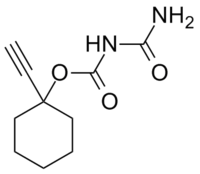Clocental
Appearance
From Wikipedia, the free encyclopedia
This is an old revision of this page, as edited by Meodipt (talk | contribs) at 07:52, 1 September 2020 (→See also). The present address (URL) is a permanent link to this revision, which may differ significantly from the current revision.
Not to be confused with Placental.
 | |
 | |
| Clinical data | |
|---|---|
| Other names | Dolcental |
| Identifiers | |
| |
| CAS Number |
|
| ChemSpider |
|
| CompTox Dashboard (EPA) | |
| Chemical and physical data | |
| Formula | C10H14N2O3 |
| Molar mass | 210.233 g·mol−1 |
| 3D model (JSmol) | |
| |
| |
Clocental (dolcental) is a carbamate-derived sedative hypnotic. It can be prepared by the ethynylation of cyclohexanone followed by reaction with allophanyl chloride.[1]

See also
References
| Alcohols | |
|---|---|
| Barbiturates |
|
| Benzodiazepines |
|
| Carbamates | |
| Flavonoids |
|
| Imidazoles | |
| Kava constituents | |
| Monoureides | |
| Neuroactive steroids |
|
| Nonbenzodiazepines | |
| Phenols | |
| Piperidinediones | |
| Pyrazolopyridines | |
| Quinazolinones | |
| Volatiles/gases |
|
| Others/unsorted |
|
Retrieved from "https://en.wikipedia.org/w/index.php?title=Clocental&oldid=976113087"
